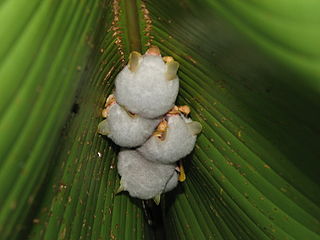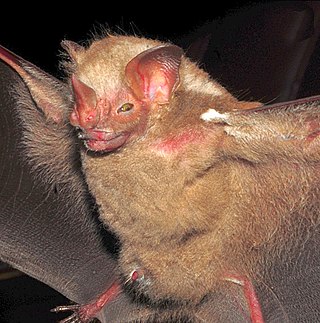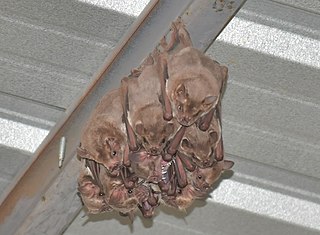
The New World leaf-nosed bats (Phyllostomidae) are bats found from southern North America to South America, specifically from the Southwest United States to northern Argentina. They are ecologically the most varied and diverse family within the order Chiroptera. Most species are insectivorous, but the phyllostomid bats include within their number true predatory species and frugivores. For example, the spectral bat, the largest bat in the Americas, eats vertebrate prey, including small, dove-sized birds. Members of this family have evolved to use food groups such as fruit, nectar, pollen, insects, frogs, other bats, and small vertebrates, and in the case of the vampire bats, even blood.

The Jamaican, common, or Mexican fruit bat is a frugivorous bat species native to the Neotropics.

The Honduran white bat, also called the Caribbean white tent-making bat, is a species of bat in the family Phyllostomatidae. It is the only member of the genus Ectophylla. The genus and the species were both scientifically described for the first time in 1892. It has distinctive, entirely white fur, which is only found in six of the roughly 1,300 known species of bat. It constructs "tents" out of understory plant leaves by strategically cutting the leaf ribs with its teeth; it roosts in these tents during the day. It is a specialist frugivore, consuming almost exclusively the fruits of one species of fig. Females can likely become pregnant twice per year, giving birth to one offspring at a time.

The dayak fruit bat or dyak fruit bat is a relatively rare frugivorous megabat species found only on the Sunda Shelf of southeast Asia, specifically the Malay Peninsula south of the Isthmus of Kra, and the islands of Borneo and Sumatra. There are three species in the genus Dyacopterus: D. spadiceus, D. brooksi and D. rickarti. All are found in the forests of Malaysia, Thailand, and the Philippines. Few specimens of any of the three species exist, due not only to their rarity, but also because they rarely enter the sub-canopy of the forest where they can be caught in scientists' nets.

The Brazilian big-eyed bat is a species of phyllostomid bat from South America. The scientific name honours Italian naturalist Giacomo Doria.

The Ipanema bat is a bat species of order Chiroptera and family Phyllostomidae. It is found in northern Argentina, Bolivia, southeastern Brazil and Paraguay. It is the only species within its genus.

The great stripe-faced bat or stripe-faced vampire bat is a bat species found from southern Mexico to Bolivia and northwestern Brazil, as well as on Trinidad. The great stripe-faced bat is a frugivore. It is one of two species within the genus Vampyrodes the other being Vampyrodes major.

The eastern or Queensland tube-nosed bat is a megabat in the family Pteropodidae that lives in north-eastern Australia. N. robinsoni is one of the few species of megabat that roosts solitarily. They get their common name from their raised tubular nostrils which are unlike those of most other species in the family. They are a deep brown with gray heads and sparse yellow spotting.

The Neotropical fruit bats (Artibeus) are a genus of bats within the subfamily Stenodermatinae. The genus consists of 12 species, which are native to Central and South America, as well as the Caribbean.

The fraternal fruit-eating bat is a species of bat in the family Phyllostomidae that is found in drier habitats in Ecuador and Peru. It was formerly considered to be a subspecies of the Jamaican fruit bat, but was raised to species level in 1978. The smallest species in the group of large Artibeus, it has a forearm length of 52–59 mm (2.0–2.3 in), a total length of 64–76 mm (2.5–3.0 in), and a weight of 30–55 g (1.1–1.9 oz).

The buffy flower bat is a species of bat in the leaf-nosed bat family, Phyllostomidae. It is found in the Bahamas, the Cayman Islands, Cuba, and Jamaica.

The harpy fruit bat is a species of megabat in the family Pteropodidae. It is endemic to the Philippines.

The Cuban fig-eating bat, or white-shouldered bat, is a species of bat in the family Phyllostomidae, found only in the Caribbean. It is the sole extant species in the genus Phyllops, although two other species, P. vetus and P. silvai, are known from fossils.

Stenodermatinae is a large subfamily of bats in the family Phyllostomidae.

Thomas's fruit-eating bat, sometimes also popularly called Watson's fruit-eating bat, is a species of bat in the family Phyllostomidae. It is found from southern Mexico, through Central America to Colombia. Its South American range is to the west of the Andes. The species name is in honor of H. J. Watson, a plantation owner in western Panama who used to send specimens to the British Natural History Museum, where Oldfield Thomas would often describe them.
Solimoea acrensis is a prehistoric ateline monkey from the Late Miocene Solimões Formation of Brazil. It is the only known species of the genus Solimoea.















